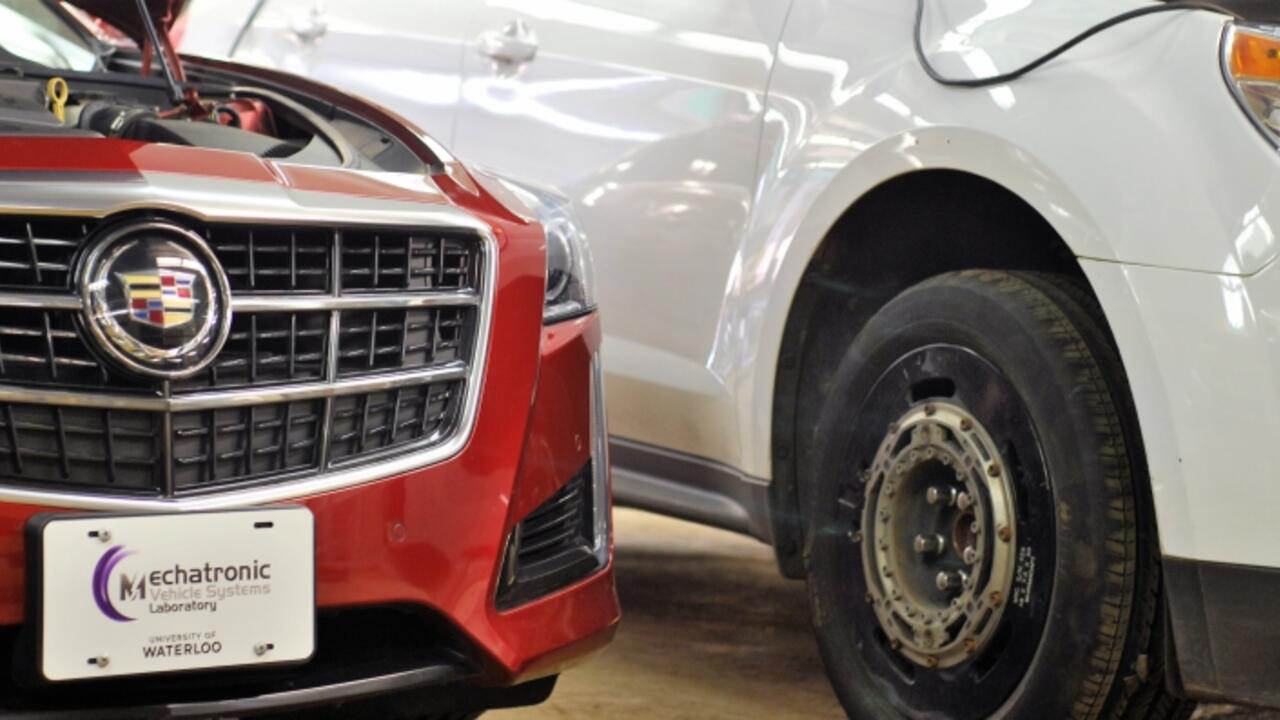
A partnership for the future of electric vehicles
Mechatronics professor Amir Khajepour thinks big

Mechatronics professor Amir Khajepour thinks big
By Julie Stauffer Faculty of Engineering Amir Khajepour may be soft-spoken, but his quiet demeanour is deceiving. This mechatronics professor thinks big. And he is ensuring that Waterloo Engineering is part of building the future of electric vehicles.
Amir Khajepour may be soft-spoken, but his quiet demeanour is deceiving. This mechatronics professor thinks big. And he is ensuring that Waterloo Engineering is part of building the future of electric vehicles.
His lab, Mechatronic Vehicle Systems Laboratory, at the University of Waterloo buzzes with more than two dozen graduate students, post-doctoral students and visiting researchers, all working to shape a new automotive future.
Khajepour heads up an $8-million, public-private research effort to develop green, intelligent transportation, and he holds a Tier 1 Canada Research Chair in Mechatronic Vehicle Systems.
Hungry for more success, he’s also poured his ambition and vision into creating the Joint Laboratory for Green and Intelligent Vehicles, a partnership with the Beijing Institute of Technology (BIT) in China.
It’s a clear example of iron sharpening iron.
For more than a decade now, the University of Waterloo and BIT have enjoyed a close relationship that includes research and academic exchanges. Waterloo brings an international reputation, especially in engineering, while the Waterloo Centre for Automotive Research (WatCAR) is the biggest centre of its kind in Canada.
Meanwhile, BIT is home to the National Engineering Laboratory for Electric Vehicles — a powerhouse that has developed more than 20 types of vehicles, including zero-emission buses that shuttled passengers between stadiums during the 2008 Summer Olympics in Beijing. BIT also boasts a Low Emission Vehicle Research Laboratory that focuses on developing clean fuel technologies, including hydrogen power, biodiesel and solar energy.
Khajepour is keen to tap into BIT’s impressive facilities, but the biggest benefit of the partnership from his perspective is the potential to access the world’s largest automotive market.
“The vehicle industry in China is huge,” he says. “It’s a ripe market for many, many things.”
The joint lab spearheaded by Khajepour contributes to Waterloo’s goal of becoming one of Canada’s most connected universities internationally. It is among hundreds of academic and research agreements helping foster insights required to tackle pressing global issues.
Through the Waterloo-BIT collaboration, researchers will be able to tap the expertise of colleagues, take advantage of world-class laboratories and fast-track breakthroughs in the field.
 “I think from both sides, that will be beneficial,” Khajepour says. “When they are coming here, they obviously see how we work, how we manage our research, what topics of research we have. And when we go there, we can understand exactly what type of problems or research their companies or industries are looking for.”
“I think from both sides, that will be beneficial,” Khajepour says. “When they are coming here, they obviously see how we work, how we manage our research, what topics of research we have. And when we go there, we can understand exactly what type of problems or research their companies or industries are looking for.”
The key is securing research funding to make the new joint lab more than an agreement on paper. Khajepour is currently scouting out potential grants. If he succeeds, top talent on both sides of the world will soon be collaborating to develop smarter, cleaner, energy-conserving cars.
And that is where the future lies.
“The whole idea of green and intelligent is exactly what the whole industry is going to,” Khajepour says.

Waterloo researcher Dr. Tizazu Mekonnen stands next to a rheometer, which is used to test the flow properties of hydrogels. (University of Waterloo)
Read more
Plant-based material developed by Waterloo researchers absorbs like commercial plastics used in products like disposable diapers - but breaks down in months, not centuries

Read more
Here are the people and events behind some of this year’s most compelling Waterloo stories

Engineering master's student Nayeema Nonta (left), one of the three paper authors, and her supervisor, Dr. Sirisha Rambhatla, in a large server room with the computer power needed to develop their new LLM training technique. (University of Waterloo)
Read more
Waterloo researchers develop highly efficient AI training system that paves the way for cheaper, greener “intelligent partners”
Read
Engineering stories
Visit
Waterloo Engineering home
Contact
Waterloo Engineering
The University of Waterloo acknowledges that much of our work takes place on the traditional territory of the Neutral, Anishinaabeg, and Haudenosaunee peoples. Our main campus is situated on the Haldimand Tract, the land granted to the Six Nations that includes six miles on each side of the Grand River. Our active work toward reconciliation takes place across our campuses through research, learning, teaching, and community building, and is co-ordinated within the Office of Indigenous Relations.